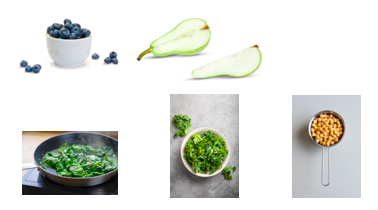by Jenna Koroly, MS, RD, CSOWM, CDN
Below we review key findings and takeaways from the research studies we featured on our Science Nook in 2021. Some common themes across the featured studies this year include the benefits of increased fiber intake from vegetables, fruits, legumes, nuts, and whole grains for cancer survivorship, as well as cancer survivors’ interest in dietitian support.
Cancer
In a prospective study, higher total intake of fruits, vegetables, and legumes was inversely associated with CVD mortality, cancer incidence, cancer mortality, and all-cause mortality in model 1 (minimally adjusted model) [i].
In this study, legumes included beans, lentils, chickpeas, black beans, peas, and black-eyed peas. One serving was defined as 125 g of fruits, 125 g of vegetables, and 150 g of cooked beans. Four to five servings of these foods per day may look like:

Consider how many servings per day you have of fruits, vegetables, and legumes. For tips on how to increase consumption of these nutritious foods, check out our recipes.
Breast Cancer
In a pooled analysis of 21 prospective cohort studies, there were no significant associations between dairy intake or calcium intake (including food and supplements) and overall breast cancer risk. There were significant inverse associations between cottage cheese/ricotta cheese intake (25 grams or more per day compared to less than 1 gram per day) and yogurt intake (60 grams or more per day compared to less than 1 gram per day) and ER-negative breast cancer risk [ii]. One 4 oz container of cottage cheese is 113 grams and one 5.3 oz container of Greek yogurt is 150 grams. There was a significant inverse trend between calcium intake from food and overall breast cancer risk, although there was no significant association for the highest intake category of 1400 mg per day [ii].
In an Interventionist-Guided program and a Self-Guided program for African American breast cancer survivors, there was no association between stress and change in physical activity in either group during the 6 month intervention or maintenance phase. There was also no association between stress and change in HEI score or central adiposity in either group during the 6 month intervention or maintenance phase [iii]. This may be due to involvement in Moving Forward, where participants may have learned to apply skills to manage stress.
In breast cancer survivors, nut consumers had higher overall survival and disease-free survival rates compared to non-consumers at 10-years post-diagnosis. Similar survival differences were found for peanut, walnut, and other nut consumption [iv].
Colorectal Cancer
In colorectal cancer survivors, consumption of whole grains, nuts, legumes, and vegetable oils showed some evidence of an inverse association with all-cause mortality. Of these, a significant inverse association was found only for nuts. Consumption of sugar-sweetened beverages was associated with a higher risk of all-cause mortality, while moderate fruit juice consumption was significantly associated with a lower risk of all-cause mortality compared to low fruit juice consumption. Greater animal fat consumption was associated with a higher risk of all-cause mortality compared with lower animal fat consumption [v].
Individuals with a higher prudent pattern score had a decreased risk of early-onset adenoma. There were suggestions of higher DASH, AMED, and AHEI-2010 scores being associated with a decreased risk of early-onset adenoma. There was a stronger association between Western dietary pattern and risk of advanced adenomas specifically in the distal colon and rectum, but not in the proximal colon [vi].
Higher dietary fiber intake was associated with lower risk of any complications and surgical complications in colorectal cancer surgery [vii].
Lung Cancer
Higher intake of fiber was associated with a lower risk of lung cancer in a dose response pattern (30.5 g compared to 8.8 g) in a prospective study. Higher intake of whole grains was associated with a lower risk of lung cancer in a dose response pattern (2.3 servings compared to 0.3 servings) [viii].
Prostate Cancer
Of those in the highest genetic risk group, a healthy lifestyle was associated with a decreased risk of lethal prostate cancer. These individuals had a 3% lifetime cumulative lethal prostate cancer incidence, compared to 6% for those in the least healthy lifestyle group. A high healthy lifestyle score included maintaining a healthy weight, engaging in vigorous physical activity, intake of fatty fish and tomatoes, decreased intake of processed meats, and lack of smoking [ix].
E-Health and Access to Nutrition Care
In a survey of over 1000 cancer survivors, 39% of participants met with a dietitian, with 74% reporting the visit to be very/extremely helpful. 56.7% of participants who did not meet with a dietitian reported that they would have liked more support regarding eating pattern [x].
In a study on E-Health tools, 89% of participants mostly, or completely, agreed that patient-reported outcome measures through tablets should be integrated into routine clinical care. Younger participants agreed significantly more than older participants. 38.2% of all participants requested nutrition supportive care on the same day after completing the questionnaires. 48.8% of those who were malnourished and distressed requested same day supportive care [xi].
Vitamin D
In a cross-sectional retrospective study, those with vitamin D deficiency were 4.6 times more likely to be positive for COVID-19 [xii]. Although additional research is needed on vitamin D supplementation for preventing and treating COVID-19, you may consider adding vitamin D rich foods into your eating pattern. These include salmon, mushrooms, fortified milks and dairy free milks, and fortified breakfast cereals. Less commonly consumed is cod liver oil, with 1 tablespoon containing 170% of the daily value of vitamin D. The next time you have your annual physical, you may want to ask your provider to check your vitamin D levels to determine if supplementation is appropriate.
References:
[i] Liu W, Hu B, Dehghan M, Mente A, Wang C, Yan R…on behalf of PURE-China Investigators. (2021). Fruit, vegetable, and legume intake and the risk of all-cause, cardiovascular, and cancer mortality: A prospective study. Clinical Nutrition. https://doi.org/10.1016/j.clnut.2021.01.016
[ii] Wu Y, Huang R, Wang M, Bernstein L, Bethea TN, Chen C…Smith-Warner SA. (2021). Dairy foods, calcium, and risk of breast cancer overall and for subtypes defined by estrogen receptor status: a pooled analysis of 21 cohort studies. The American Journal of Clinical Nutrition;0:1-12, https://doi.org/10.1093/ajcn/nqab097
[iii] Kwarteng JL, Matthews L, Banerjee A, Sharp LK, Gerber BS, Stolley MR. (2021). The association of stressful life events on weight loss efforts among African American breast cancer survivors. Journal of Cancer Survivorship. https://doi.org/10.1007/s11764-021-01054-2
[iv] Wang C, Gu K, Wang F, Cai H, Zheng W, Bao P, Shu X (2021). Nut consumption in association with overall mortality and recurrence/disease-specific mortality among long-term breast cancer survivors. Cancer Epidemiology. https://doi.org/10.1002/ijc.33824
[v] Ratjen I, Enderle J, Burmeister G, Koch M, Nothlings U, Hampe J, Lieb W. (2021). Post-diagnostic reliance on plant- compared with animal-based foods and all-cause mortality in omnivorous long-term colorectal cancer survivors. The American Journal of Clinical Nutrition, nqab061, https://doi.org/10.1093/ajcn/nqab061
[vi] Zheng X, Hur J, Nguyen LH, Liu J, Song M, Wu K…Cao Y (2021). Comprehensive assessment of diet quality and risk of precursors of early-onset colorectal cancer. Journal of National Cancer Institute, 113(5). https://doi.org/10.1093/jnci/djaa164
[vii] Kok DE, Arron MNN, Huibregtse T, Kruyt FM, Bac DJ, van Halteren HK…Kampman E (2021). Association of habitual preoperative dietary fiber intake with complications after colorectal cancer surgery. JAMA Surgery, 156(9):827-835. https://doi.org/10.1001/jamasurg.2021.2311
[viii] Tao J, Jatoi A, Crawford J, Lam WWT, Ho JC, Wang X, and Pang H. (2021). Role of dietary carbohydrates on risk of lung cancer. Lung Cancer. https://doi.org/10.1016/j.lungcan.2021.03.009
[ix] Plym A, Zhang Y, Stopsack K, Delcoigne B, Kibel AS, Giovannucci E…Mucci LA. (2021). Can the genetic risk of prostate cancer be attenuated by a healthy lifestyle? [abstract]. In: Proceedings of the 112th Annual Meeting of the American Association for Cancer Research; 2021 April 10-15. Philadelphia (PA): AACR; 2021. Abstract nr 822. https://www.abstractsonline.com/pp8/#!/9325/presentation/1890
[x] Sullivan ES, Rice N, Kingston E, Kelly A, Reynolds JV, Feighan J…Ryan AM. (2020). A national survey of oncology survivors examining nutrition attitudes, problems and behaviors, and access to dietetic care throughout the cancer journey. Clinical Nutrition ESPEN, 1-9. https://doi.org/10.1016/j.clnesp.2020.10.023
[xi] Erickson N, Schinkoethe T, Eckhardt C, Storck L, Joos A, Liu L…Heinemann V (2021). Patient-reported outcome measures obtained via E-Health tools ease the assessment burden and encourage patient participation in cancer care (PaCC Study). Supportive Care in Cancer, 29(12):7715-7724. https://doi.org/10.1007/s00520-021-06351-1
[xii] Katz J, Yue S, Xue W. (2021). Increased risk for COVID-19 in patients with vitamin D deficiency. Nutrition, 84. https://doi.org/10.1016/j.nut.2020.111106


 Susan started Savor Health after losing a close friend to a brain tumor and, through that experience, becoming aware of the significant unmet nutritional needs of people with cancer. Struck by the fact that her friend was told “nutrition doesn’t matter” and “eat whatever you want,” Susan read the evidence-based literature on the subject, interviewed oncologists, oncology nurses and oncology dietitians, as well as patients and caregivers, and found that, in fact, nutrition does matter in oncology. Armed with solid scientific evidence supporting the clinical and quality of life benefits of proper nutrition, Susan left Wall Street and created Savor Health, an AI-based provider of personalized and clinically appropriate nutrition solutions for cancer patients, their caregivers and health enterprises. Susan brings to Savor Health over 25 years of industry experience in healthcare and business as well as expertise in strategy, finance and management.
Susan started Savor Health after losing a close friend to a brain tumor and, through that experience, becoming aware of the significant unmet nutritional needs of people with cancer. Struck by the fact that her friend was told “nutrition doesn’t matter” and “eat whatever you want,” Susan read the evidence-based literature on the subject, interviewed oncologists, oncology nurses and oncology dietitians, as well as patients and caregivers, and found that, in fact, nutrition does matter in oncology. Armed with solid scientific evidence supporting the clinical and quality of life benefits of proper nutrition, Susan left Wall Street and created Savor Health, an AI-based provider of personalized and clinically appropriate nutrition solutions for cancer patients, their caregivers and health enterprises. Susan brings to Savor Health over 25 years of industry experience in healthcare and business as well as expertise in strategy, finance and management. Marissa Buchan is a registered dietitian, with advanced practice certifications in Oncology Nutrition (CSO) and Clinical Research (CCRP). She received her Bachelor’s degree in Psychology from Duke University, and Master’s of Science degree in Clinical Nutrition from New York University. Marissa worked for 10 years at Memorial Sloan Kettering Cancer Center in both the clinical research and nutrition departments. In addition to counseling patients before, during, and after cancer therapy, she spearheaded nutrition-research efforts for the bone marrow transplant service. She has co-authored over 20 articles and has a particular interest in the role of nutrition on the intestinal microbiota and its impact on patient outcomes. When Marissa’s not wearing her lab coat, she’s in her apron whipping up healthy and delicious recipes that you can find on her blog, Get Off Your Tush and Cook.
Marissa Buchan is a registered dietitian, with advanced practice certifications in Oncology Nutrition (CSO) and Clinical Research (CCRP). She received her Bachelor’s degree in Psychology from Duke University, and Master’s of Science degree in Clinical Nutrition from New York University. Marissa worked for 10 years at Memorial Sloan Kettering Cancer Center in both the clinical research and nutrition departments. In addition to counseling patients before, during, and after cancer therapy, she spearheaded nutrition-research efforts for the bone marrow transplant service. She has co-authored over 20 articles and has a particular interest in the role of nutrition on the intestinal microbiota and its impact on patient outcomes. When Marissa’s not wearing her lab coat, she’s in her apron whipping up healthy and delicious recipes that you can find on her blog, Get Off Your Tush and Cook. Dr. DeFrance has a unique background including clinical interventional cardiologist, chief medical officer, educator, outcomes researcher and entrepreneur. He has expertise in Lifestyle medicine in which he was board certified in 2020 and is highly interested in the prevention and reversal of chronic disease. Dr. DeFrance also has expertise in appropriate utilization of technology in medicine, healthcare economics, value-based metrics, and educational design and delivery. He worked as Chief Medical Officer for HealthHelp, one of the largest specialty benefit managers in the US, and led large teams of healthcare professionals in writing evidence based appropriate care guidelines and rule sets which improve the quality and safety of medicine for over 20 million people in the US while also creating sustained savings in healthcare. He has also designed clinical decision support systems that are currently in use helping to improve patient care.
Dr. DeFrance has a unique background including clinical interventional cardiologist, chief medical officer, educator, outcomes researcher and entrepreneur. He has expertise in Lifestyle medicine in which he was board certified in 2020 and is highly interested in the prevention and reversal of chronic disease. Dr. DeFrance also has expertise in appropriate utilization of technology in medicine, healthcare economics, value-based metrics, and educational design and delivery. He worked as Chief Medical Officer for HealthHelp, one of the largest specialty benefit managers in the US, and led large teams of healthcare professionals in writing evidence based appropriate care guidelines and rule sets which improve the quality and safety of medicine for over 20 million people in the US while also creating sustained savings in healthcare. He has also designed clinical decision support systems that are currently in use helping to improve patient care.
 Alyson is a registered nurse and is certified in oncology nursing (OCN) through the Oncology Nursing Society (ONS). She also has her certification as an ONS Biotherapy and Chemotherapy Provider. Alyson studied nursing at Thomas Jefferson University where she obtained her Bachelor’s of Science in Nursing (BSN). Since starting her nursing career in 2004, Alyson has had a strong dedication and commitment to oncology patients. She has worked inpatient specializing in Bone Marrow and Peripheral Blood Stem Cell Transplantation. Alyson currently works in outpatient oncology at the North Shore-LIJ Monter Cancer Center. Alyson is part of the clinical team at Savor Health where she counsels patients on oncology and oncology nutrition issues and contributes to website and other Savor Health content.
Alyson is a registered nurse and is certified in oncology nursing (OCN) through the Oncology Nursing Society (ONS). She also has her certification as an ONS Biotherapy and Chemotherapy Provider. Alyson studied nursing at Thomas Jefferson University where she obtained her Bachelor’s of Science in Nursing (BSN). Since starting her nursing career in 2004, Alyson has had a strong dedication and commitment to oncology patients. She has worked inpatient specializing in Bone Marrow and Peripheral Blood Stem Cell Transplantation. Alyson currently works in outpatient oncology at the North Shore-LIJ Monter Cancer Center. Alyson is part of the clinical team at Savor Health where she counsels patients on oncology and oncology nutrition issues and contributes to website and other Savor Health content. Chelsey is a Registered Dietitian and Board Certified Specialist in Oncology nutrition (CSO). She completed her Dietetic Internship at Northwell Health, received her BS in Dietetics at the University of Wisconsin-Madison, and her MS in Nutrition at Stony Brook University’s School of Medicine. Chelsey works as an outpatient dietitian at Mount Sinai covering all of the downtown cancer services at Mount Sinai Beth Israel and Philips Ambulatory Care Center. Chelsey works with patients and families before, during and after treatment to optimize their nutrition through dietary counseling and support. Chelsey has experience counseling clients with a variety of diagnoses including breast cancer, lung cancer, prostate cancer, head & neck cancer, and more. Chelsey also enjoys sharing nutrition knowledge with her peers by running a monthly Employee Wellness program that showcases healthy topics, recipes and food demos.
Chelsey is a Registered Dietitian and Board Certified Specialist in Oncology nutrition (CSO). She completed her Dietetic Internship at Northwell Health, received her BS in Dietetics at the University of Wisconsin-Madison, and her MS in Nutrition at Stony Brook University’s School of Medicine. Chelsey works as an outpatient dietitian at Mount Sinai covering all of the downtown cancer services at Mount Sinai Beth Israel and Philips Ambulatory Care Center. Chelsey works with patients and families before, during and after treatment to optimize their nutrition through dietary counseling and support. Chelsey has experience counseling clients with a variety of diagnoses including breast cancer, lung cancer, prostate cancer, head & neck cancer, and more. Chelsey also enjoys sharing nutrition knowledge with her peers by running a monthly Employee Wellness program that showcases healthy topics, recipes and food demos. Michelle is a Registered Dietitian specializing in oncology. She works as a clinical dietitian at an ambulatory cancer center in New York City and is a consultant for Savor Health. She is passionate about educating oncology patients on the importance of nutrition during their fight against cancer and helping them to optimize their nutrition through all phases of treatment. Michelle received her Bachelor of Science degree in dietetics from the University of Wisconsin-Madison and her Master of Science degree in Clinical Nutrition from New York University.
Michelle is a Registered Dietitian specializing in oncology. She works as a clinical dietitian at an ambulatory cancer center in New York City and is a consultant for Savor Health. She is passionate about educating oncology patients on the importance of nutrition during their fight against cancer and helping them to optimize their nutrition through all phases of treatment. Michelle received her Bachelor of Science degree in dietetics from the University of Wisconsin-Madison and her Master of Science degree in Clinical Nutrition from New York University. Denise Sievering is a Registered Dietitian who is board certified in Oncology Nutrition as well as Nutrition Support. A fluent Spanish speaker, Denise joined the Savor Health team to support Spanish speaking cancer patients and to continue to expand the Platform’s nutritional strategies and recommendations in Spanish. Denise holds a Bachelor of Science degree from Rutgers University, and completed her internship at New York Presbyterian Hospital (NYP). Denise started her career as a registered dietitian at NYP-Columbia University Medical Center, primarily covering inpatient Oncology units. Denise also holds a Master of Arts degree in Mental Health Counseling from New York University, and incorporates her advanced training in motivational interviewing and empathic listening in her patient encounters, particularly those whose lives have been forever changed by a cancer diagnosis. A New Jersey native, Denise now resides in sunny San Diego, CA where she works as a part-time outpatient Oncology dietitian at Scripps Health-MD Anderson Cancer Center, and also works as an inpatient dietitian at Kaiser Permanente. In her spare time, Denise can be found at a mom-and-pop taco shop, one of the many local craft breweries, and exploring her new city of San Diego with her husband and her rescue pup, Ripley.
Denise Sievering is a Registered Dietitian who is board certified in Oncology Nutrition as well as Nutrition Support. A fluent Spanish speaker, Denise joined the Savor Health team to support Spanish speaking cancer patients and to continue to expand the Platform’s nutritional strategies and recommendations in Spanish. Denise holds a Bachelor of Science degree from Rutgers University, and completed her internship at New York Presbyterian Hospital (NYP). Denise started her career as a registered dietitian at NYP-Columbia University Medical Center, primarily covering inpatient Oncology units. Denise also holds a Master of Arts degree in Mental Health Counseling from New York University, and incorporates her advanced training in motivational interviewing and empathic listening in her patient encounters, particularly those whose lives have been forever changed by a cancer diagnosis. A New Jersey native, Denise now resides in sunny San Diego, CA where she works as a part-time outpatient Oncology dietitian at Scripps Health-MD Anderson Cancer Center, and also works as an inpatient dietitian at Kaiser Permanente. In her spare time, Denise can be found at a mom-and-pop taco shop, one of the many local craft breweries, and exploring her new city of San Diego with her husband and her rescue pup, Ripley. Karen is a Registered Dietitian, Board Certified Specialist in Oncology Nutrition and registered in New York as a Certified Dietitian Nutritionist. Fluent in Spanish, Karen joined the Savor Health team to support Spanish speaking cancer patients and to continue to expand the Platform’s nutritional strategies and recommendations in Spanish. Karen received her Bachelor of Science degree from Ithaca College and her Master of Science degree from Hunter College. She works as an outpatient oncology dietitian in New York. Karen often works with local community centers to host nutrition programs for cancer survivors and their families, leading classes on how to live healthier lifestyles throughout their continuum of care. The American Institute of Cancer Research selected to showcase one of her many programs at their conference in 2019. Karen has written for and lent commentary to various publications and truly enjoys teaching people how to eat better. She loves to cook and strongly feels that healthy food doesn’t have to taste bad.
Karen is a Registered Dietitian, Board Certified Specialist in Oncology Nutrition and registered in New York as a Certified Dietitian Nutritionist. Fluent in Spanish, Karen joined the Savor Health team to support Spanish speaking cancer patients and to continue to expand the Platform’s nutritional strategies and recommendations in Spanish. Karen received her Bachelor of Science degree from Ithaca College and her Master of Science degree from Hunter College. She works as an outpatient oncology dietitian in New York. Karen often works with local community centers to host nutrition programs for cancer survivors and their families, leading classes on how to live healthier lifestyles throughout their continuum of care. The American Institute of Cancer Research selected to showcase one of her many programs at their conference in 2019. Karen has written for and lent commentary to various publications and truly enjoys teaching people how to eat better. She loves to cook and strongly feels that healthy food doesn’t have to taste bad. Allie is a Registered Dietitian and a Certified Specialist in Oncology (CSO). She joins Savor in 2023, bringing years of experience from the John Theurer Cancer Center in New Jersey, where she worked with patients with a variety of cancers. Her goal is to help people feel their best, both mentally and physically, when physical health challenges arise. She believes in the power of nutrition ever since the impact it made on her athletic career as a volleyball player during college. Allie graduated with her Bachelor of Science degree from University of Maryland-Baltimore County and has her Master’s degree in Human Nutrition from the University of Wisconsin Stout. She enjoys travelling, enjoying different cuisines, cooking, and hiking and other outdoor activities with her family and dog.
Allie is a Registered Dietitian and a Certified Specialist in Oncology (CSO). She joins Savor in 2023, bringing years of experience from the John Theurer Cancer Center in New Jersey, where she worked with patients with a variety of cancers. Her goal is to help people feel their best, both mentally and physically, when physical health challenges arise. She believes in the power of nutrition ever since the impact it made on her athletic career as a volleyball player during college. Allie graduated with her Bachelor of Science degree from University of Maryland-Baltimore County and has her Master’s degree in Human Nutrition from the University of Wisconsin Stout. She enjoys travelling, enjoying different cuisines, cooking, and hiking and other outdoor activities with her family and dog. Julia Penberg is a seasoned healthcare professional with more than 30 years of experience focusing on maximizing operational excellence, leading clinical program development and building strong cross-functional teams. Her previous roles include overseeing the performance of clinical managers and nurse practitioners across multiple markets within United Healthcare-Optum’s Medicare Advantage and dual-eligible special needs populations, payer outreach and program development at Mayo Clinic, ground level specialty hospital development and direct patient care as a family and dermatology nurse practitioner. Julia volunteered as an operating room nurse and nurse practitioner on several mission trips to Romania and was a support group leader for the Kansas City chapter of the International Myeloma Foundation. Her motivation throughout her career has been with wellness promotion, disease risk modification and ensuring the best patient experience across the health continuum. Ms. Penberg received an MBA from the University of Dallas; a MS in Nursing from the University of Kansas and a BS in Nursing from the University of Texas-Austin. She is board certified as a Family Nurse Practitioner.
Julia Penberg is a seasoned healthcare professional with more than 30 years of experience focusing on maximizing operational excellence, leading clinical program development and building strong cross-functional teams. Her previous roles include overseeing the performance of clinical managers and nurse practitioners across multiple markets within United Healthcare-Optum’s Medicare Advantage and dual-eligible special needs populations, payer outreach and program development at Mayo Clinic, ground level specialty hospital development and direct patient care as a family and dermatology nurse practitioner. Julia volunteered as an operating room nurse and nurse practitioner on several mission trips to Romania and was a support group leader for the Kansas City chapter of the International Myeloma Foundation. Her motivation throughout her career has been with wellness promotion, disease risk modification and ensuring the best patient experience across the health continuum. Ms. Penberg received an MBA from the University of Dallas; a MS in Nursing from the University of Kansas and a BS in Nursing from the University of Texas-Austin. She is board certified as a Family Nurse Practitioner. Rachel is a Registered Dietitian and Board Certified Specialist in Oncology Nutrition (“CSO”). She joined NYP-Columbia as the outpatient oncology dietitian in 2020 after working at Jamaica Hospital Medical Center for two years. Rachel completed her dietetic internship through Keene State College in 2017. She is pursuing an MS in Integrative Nutrition at Stony Brook University and has a BS in Human Nutrition, Foods and Exercise from Virginia Tech. Rachel provides nutrition counseling to all types of oncology patients and helps them understand the mental and physical benefits of nutrition as an ally in their fight against cancer. In her free time she enjoys slow meals with family and friends, Pilates, and tending to her fire escape garden.
Rachel is a Registered Dietitian and Board Certified Specialist in Oncology Nutrition (“CSO”). She joined NYP-Columbia as the outpatient oncology dietitian in 2020 after working at Jamaica Hospital Medical Center for two years. Rachel completed her dietetic internship through Keene State College in 2017. She is pursuing an MS in Integrative Nutrition at Stony Brook University and has a BS in Human Nutrition, Foods and Exercise from Virginia Tech. Rachel provides nutrition counseling to all types of oncology patients and helps them understand the mental and physical benefits of nutrition as an ally in their fight against cancer. In her free time she enjoys slow meals with family and friends, Pilates, and tending to her fire escape garden. Allie Werner is a Registered Dietitian at Fresenius Kidney Care where she provides medical nutrition therapy diet counseling to patients on Dialysis. She received her Bachelor’s Degree in nutrition from Indiana University and completed her Master’s Degree and dietetic internship at Loyola University Chicago. In her free time she enjoys spending time with friends and family, checking out the amazing food scene in downtown Chicago, and exercising on her Peloton bike.
Allie Werner is a Registered Dietitian at Fresenius Kidney Care where she provides medical nutrition therapy diet counseling to patients on Dialysis. She received her Bachelor’s Degree in nutrition from Indiana University and completed her Master’s Degree and dietetic internship at Loyola University Chicago. In her free time she enjoys spending time with friends and family, checking out the amazing food scene in downtown Chicago, and exercising on her Peloton bike. Immersed in the tech world for a decade, I've coded, led teams, and honed my skills in architecture and design. As a tech enthusiast, I've seamlessly woven through full-stack projects, fusing my love for code with the art of leadership.
Immersed in the tech world for a decade, I've coded, led teams, and honed my skills in architecture and design. As a tech enthusiast, I've seamlessly woven through full-stack projects, fusing my love for code with the art of leadership. Mohit is a full-stack developer with expertise in Python and JavaScript, known for his efficient coding and ability to deliver scalable software solutions. His technical contributions are highlighted on GitHub and Stack Overflow, demonstrating his commitment to the tech community and problem-solving skills. With a solid educational foundation and a diverse project portfolio, Mohit excels at navigating complex challenges and is well-equipped to contribute to dynamic software projects.
Mohit is a full-stack developer with expertise in Python and JavaScript, known for his efficient coding and ability to deliver scalable software solutions. His technical contributions are highlighted on GitHub and Stack Overflow, demonstrating his commitment to the tech community and problem-solving skills. With a solid educational foundation and a diverse project portfolio, Mohit excels at navigating complex challenges and is well-equipped to contribute to dynamic software projects. Rayna McCann is a Registered Dietitian and Board Certified Specialist in Oncology Nutrition. She is a Registered Yoga Teacher and yoga4cancer certified. She received her BS in Nutrition at Penn State University and her MS from Stony Brook University. For work, Rayna wears many hats in the world of nutrition and worked for years in clinical settings focusing on oncology nutrition. She is also an Adjunct Professor and passionate about inspiring the future of dietitians. Throughout her career, she has received awards recognizing her dedication to patient safety and her contributions to improving malnutrition awareness. In 2022, Rayna was proud to accept the ‘Dietitian of the Year’ award through the Long Island Academy of Nutrition and Dietetics. Rayna has co-authored abstracts for poster presentations within the American Institute for Cancer Research conference, as well as, the Nutrition and Dietetics Food and Nutrition Conference Expo and subsequent publication. She has enjoyed authoring articles, including an article for The Cure magazine regarding Multiple Myeloma and nutrition. When Rayna is not participating in nutrition related activities, she is dedicated to dog rescue.
Rayna McCann is a Registered Dietitian and Board Certified Specialist in Oncology Nutrition. She is a Registered Yoga Teacher and yoga4cancer certified. She received her BS in Nutrition at Penn State University and her MS from Stony Brook University. For work, Rayna wears many hats in the world of nutrition and worked for years in clinical settings focusing on oncology nutrition. She is also an Adjunct Professor and passionate about inspiring the future of dietitians. Throughout her career, she has received awards recognizing her dedication to patient safety and her contributions to improving malnutrition awareness. In 2022, Rayna was proud to accept the ‘Dietitian of the Year’ award through the Long Island Academy of Nutrition and Dietetics. Rayna has co-authored abstracts for poster presentations within the American Institute for Cancer Research conference, as well as, the Nutrition and Dietetics Food and Nutrition Conference Expo and subsequent publication. She has enjoyed authoring articles, including an article for The Cure magazine regarding Multiple Myeloma and nutrition. When Rayna is not participating in nutrition related activities, she is dedicated to dog rescue. Former Senior Vice-President, head of Strategies and Performance at Nestlé global HQ, Valerio is a leading innovation enabler who offers his expertise to a broad spectrum of start-ups, agencies and consulting companies as they expand their businesses and offerings.
Former Senior Vice-President, head of Strategies and Performance at Nestlé global HQ, Valerio is a leading innovation enabler who offers his expertise to a broad spectrum of start-ups, agencies and consulting companies as they expand their businesses and offerings. Vera has dedicated her professional life to creating innovative digital solutions at the intersection of science and technology. Her most recent engagement was with Nestlé Research, where Vera established the Digital Nutrition & Health group and led the development of Digital Food Safety department.
Vera has dedicated her professional life to creating innovative digital solutions at the intersection of science and technology. Her most recent engagement was with Nestlé Research, where Vera established the Digital Nutrition & Health group and led the development of Digital Food Safety department. Dr. Becker has served in many roles throughout her career as a Transplant Surgeon. She is currently Vice President and Chief Medical Officer at LifeGift, an organ transplant procurement organization. Dr. Becker is a Past President of the Organ Procurement and Transplant Network/United Network for Organ Sharing (“OPTN/UNOS”) Board of Directors and served during tumultuous times. While serving as OPTN President, lung allocation and liver allocations were both amended to decrease geographic disparities. She has most recently served on the UNOS corporate affairs committee as an advisor. Dr. Becker is a former committee member for the National Academy of Science, Engineering and Medicine. She is currently serving on the Kidney Disease Improving Global Outcomes (KDIGO) steering committee as the Co-Chair of a workgroup assessing patient factors contributing to kidney graft loss.
Dr. Becker has served in many roles throughout her career as a Transplant Surgeon. She is currently Vice President and Chief Medical Officer at LifeGift, an organ transplant procurement organization. Dr. Becker is a Past President of the Organ Procurement and Transplant Network/United Network for Organ Sharing (“OPTN/UNOS”) Board of Directors and served during tumultuous times. While serving as OPTN President, lung allocation and liver allocations were both amended to decrease geographic disparities. She has most recently served on the UNOS corporate affairs committee as an advisor. Dr. Becker is a former committee member for the National Academy of Science, Engineering and Medicine. She is currently serving on the Kidney Disease Improving Global Outcomes (KDIGO) steering committee as the Co-Chair of a workgroup assessing patient factors contributing to kidney graft loss. Jon Bond is one of the advertising and marketing industry’s most recognized thought leaders and entrepreneurs. He has developed several significant companies and marketing concepts over his 30-year career. Jon was Co-Founder and CEO of Kirshenbaum Bond and Partners (KBP). KBP was the first to develop the modern multi-disciplinary, integrated agency. He was CEO of Big Fuel (now part of Publicis) and co-founded and sold one of the first online media agencies (iballs) to Microsoft. Currently, Jon is founder and Chief Tomorroist at TOMORRO. Established in 2012, TOMORRO is a value accelerator using marketing, innovation, and strategic business development to help visionary companies achieve their ambitions.
Jon Bond is one of the advertising and marketing industry’s most recognized thought leaders and entrepreneurs. He has developed several significant companies and marketing concepts over his 30-year career. Jon was Co-Founder and CEO of Kirshenbaum Bond and Partners (KBP). KBP was the first to develop the modern multi-disciplinary, integrated agency. He was CEO of Big Fuel (now part of Publicis) and co-founded and sold one of the first online media agencies (iballs) to Microsoft. Currently, Jon is founder and Chief Tomorroist at TOMORRO. Established in 2012, TOMORRO is a value accelerator using marketing, innovation, and strategic business development to help visionary companies achieve their ambitions. Eliza is passionate about helping people live healthier and more fulfilling lives. She has held leadership, advisory and consulting roles at numerous health-focused companies, including RunKeeper, MyFitnessPal/Under Armour, Foodsmart (formerly Zipongo), January AI (precision health), Allara Health (women’s health) and Everyday Health (and their acquisition of weight-loss app, Lose It!). Eliza is a business operator with a track record of building and inspiring high-performing teams to deliver outstanding results and scale effectively. She has a foundation in finance and consulting and 10+ years of operational leadership at Bay Area startups, including two successful exists (MyFitnessPal, Ooyala). Eliza completed her MBA at Harvard Business School and graduated magna cum laude from Middlebury College with a double major in Art History & Economics. She is a Boston native living in New York with her husband and three children.
Eliza is passionate about helping people live healthier and more fulfilling lives. She has held leadership, advisory and consulting roles at numerous health-focused companies, including RunKeeper, MyFitnessPal/Under Armour, Foodsmart (formerly Zipongo), January AI (precision health), Allara Health (women’s health) and Everyday Health (and their acquisition of weight-loss app, Lose It!). Eliza is a business operator with a track record of building and inspiring high-performing teams to deliver outstanding results and scale effectively. She has a foundation in finance and consulting and 10+ years of operational leadership at Bay Area startups, including two successful exists (MyFitnessPal, Ooyala). Eliza completed her MBA at Harvard Business School and graduated magna cum laude from Middlebury College with a double major in Art History & Economics. She is a Boston native living in New York with her husband and three children. Ethan Basch is an oncologist and cancer researcher at the University of North Carolina, where he is Chief of Oncology and Physician-in-Chief of the Cancer Hospital. Dr. Basch has conducted research on patient-centered cancer care models for the past two decades, developing connected health technologies and care delivery strategies to improve quality of care and the patient experience. His research group established that care teams miss more than half of patients’ symptoms during cancer care, and demonstrated that electronic tools not only can close that gap, but can improve cancer outcomes including quality of life, hospitalizations, and overall survival. He has published over 300 scientific papers on these topics, including in JAMA, New England Journal of Medicine, Lancet, Journal of Clinical Oncology, JAMA Oncology, Cancer, etc. He has served on the Board of Scientific Advisors of the National Cancer Institute, the Board of Directors of the American Society of Clinical Oncology (ASCO), the Board of the International Society of Quality of Life Research (ISOQOL), and as an editor for JAMA. He received his MD at Harvard Medical School, residency training at Massachusetts General Hospital, and oncology training at Memorial Sloan Kettering Cancer Center, where he was on faculty until moving to North Carolina in 2012. The mission of his work is to improve the experiences and quality of life of people with cancer.
Ethan Basch is an oncologist and cancer researcher at the University of North Carolina, where he is Chief of Oncology and Physician-in-Chief of the Cancer Hospital. Dr. Basch has conducted research on patient-centered cancer care models for the past two decades, developing connected health technologies and care delivery strategies to improve quality of care and the patient experience. His research group established that care teams miss more than half of patients’ symptoms during cancer care, and demonstrated that electronic tools not only can close that gap, but can improve cancer outcomes including quality of life, hospitalizations, and overall survival. He has published over 300 scientific papers on these topics, including in JAMA, New England Journal of Medicine, Lancet, Journal of Clinical Oncology, JAMA Oncology, Cancer, etc. He has served on the Board of Scientific Advisors of the National Cancer Institute, the Board of Directors of the American Society of Clinical Oncology (ASCO), the Board of the International Society of Quality of Life Research (ISOQOL), and as an editor for JAMA. He received his MD at Harvard Medical School, residency training at Massachusetts General Hospital, and oncology training at Memorial Sloan Kettering Cancer Center, where he was on faculty until moving to North Carolina in 2012. The mission of his work is to improve the experiences and quality of life of people with cancer. David Raben, M.D. is currently V.P. and Chief Medical Officer, Bicara Therapeutics. Dr. Raben is also on faculty at the University of Colorado where he is a board-certified Professor of Radiation Oncology and has recently been named a U.S. News Top Doctor. He received a B.A. in Psychology from Duke University in 1985 and completed his M.D. at Wake Forest University/Bowman Grey School of Medicine in 1990. After graduation, he completed residency in Radiation Oncology at the Johns Hopkins Hospital from 1991-1994, serving as a chief resident in 1994. Dr. Raben has developed nationally recognized clinical expertise over the past 20 years in the management of head and neck cancer (HNC), lung cancer and prostate/bladder cancers. Clinically, Dr. Raben has a strong interest in nutritional precision for patients, with an interest in reducing processed foods and sugars in patients with locally advanced cancers, especially ones with high cell turnover. An anti-inflammatory strategy with a Mediterranean dietary approach coupled with reductions in high carbohydrate loading may reduce or slow cancer progression and improve a patient’s intrinsic microbiome to enhance immune response to various therapies including immune enabling drugs like checkpoint inhibitors that have shown dramatic success recently in advanced cancers. From a research perspective, his focus has been on laboratory discoveries and innovative clinical trials in areas such as high risk, heavy smoker HNC patients and has explored approaches that inhibit cancer DNA repair or growth factor signaling. Dr. Raben recently completed the first Phase I clinical trial in the US with and oral DNA repair inhibitor (PARP inhibitor) and radiation for heavy smokers when combined with intensity modulated radiation (IMRT). His efforts currently center around evaluation of TGFb inhibition in HNSCC as well as the use of radiation to stimulate activity of immune enabling drugs. Nationally, Dr. Raben serves on the NRG Oncology head and neck steering committee as well as co-chairing the Developmental Therapeutics Co-Chair at the NRG. He actively serves as an ASCO Ambassador for Multidisciplinary Cancer Management Courses (MCMC) to help educate underserved areas around the world in cancer care. Finally, he serves an ad hoc reviewer for high impact journals such as Journal of Clinical Oncology, Annals of Oncology, JAMA Oncology, Oral Oncology, Head and Neck, Int. Journal of Radiation Oncology Biology Physics, Clinical Cancer Research and Cancer Research. He has authored over 140 publications.
David Raben, M.D. is currently V.P. and Chief Medical Officer, Bicara Therapeutics. Dr. Raben is also on faculty at the University of Colorado where he is a board-certified Professor of Radiation Oncology and has recently been named a U.S. News Top Doctor. He received a B.A. in Psychology from Duke University in 1985 and completed his M.D. at Wake Forest University/Bowman Grey School of Medicine in 1990. After graduation, he completed residency in Radiation Oncology at the Johns Hopkins Hospital from 1991-1994, serving as a chief resident in 1994. Dr. Raben has developed nationally recognized clinical expertise over the past 20 years in the management of head and neck cancer (HNC), lung cancer and prostate/bladder cancers. Clinically, Dr. Raben has a strong interest in nutritional precision for patients, with an interest in reducing processed foods and sugars in patients with locally advanced cancers, especially ones with high cell turnover. An anti-inflammatory strategy with a Mediterranean dietary approach coupled with reductions in high carbohydrate loading may reduce or slow cancer progression and improve a patient’s intrinsic microbiome to enhance immune response to various therapies including immune enabling drugs like checkpoint inhibitors that have shown dramatic success recently in advanced cancers. From a research perspective, his focus has been on laboratory discoveries and innovative clinical trials in areas such as high risk, heavy smoker HNC patients and has explored approaches that inhibit cancer DNA repair or growth factor signaling. Dr. Raben recently completed the first Phase I clinical trial in the US with and oral DNA repair inhibitor (PARP inhibitor) and radiation for heavy smokers when combined with intensity modulated radiation (IMRT). His efforts currently center around evaluation of TGFb inhibition in HNSCC as well as the use of radiation to stimulate activity of immune enabling drugs. Nationally, Dr. Raben serves on the NRG Oncology head and neck steering committee as well as co-chairing the Developmental Therapeutics Co-Chair at the NRG. He actively serves as an ASCO Ambassador for Multidisciplinary Cancer Management Courses (MCMC) to help educate underserved areas around the world in cancer care. Finally, he serves an ad hoc reviewer for high impact journals such as Journal of Clinical Oncology, Annals of Oncology, JAMA Oncology, Oral Oncology, Head and Neck, Int. Journal of Radiation Oncology Biology Physics, Clinical Cancer Research and Cancer Research. He has authored over 140 publications. Jason Montrie is an award-winning healthcare technology executive and entrepreneur with over two decades of experience in building, growing, and scaling leading healthcare businesses. With a career that includes working at large health insurance companies like Humana, being Co-founder and CEO of the fastest growing heath insurance company in Illinois, and most recently serving as President of the premier healthcare data analytics platform and supplemental benefits company in the Medicare Advantage sector in Pareto Intelligence and Convey Health Solutions, Jason brings un unmatched set of experience and perspective to Savor which will help drive its growth.
Jason Montrie is an award-winning healthcare technology executive and entrepreneur with over two decades of experience in building, growing, and scaling leading healthcare businesses. With a career that includes working at large health insurance companies like Humana, being Co-founder and CEO of the fastest growing heath insurance company in Illinois, and most recently serving as President of the premier healthcare data analytics platform and supplemental benefits company in the Medicare Advantage sector in Pareto Intelligence and Convey Health Solutions, Jason brings un unmatched set of experience and perspective to Savor which will help drive its growth. Jonathan M. Kurie, M.D. Professor, Department of Thoracic/Head and Neck Medical Oncology, MD Anderson.
Jonathan M. Kurie, M.D. Professor, Department of Thoracic/Head and Neck Medical Oncology, MD Anderson. Stephanie is a Registered Dietitian and Board Certified Specialist in Oncology Nutrition (CSO). She completed her dietetic internship at NewYork-Presbyterian in 2016 and has a MS in Clinical Nutrition and BA in Biology from New York University. She has worked at NYP Weill Cornell in NYC as an oncology dietitian since 2017. Stephanie combines her passions for food and science by providing individualized nutrition counseling for patients during their medical, radiation and/or surgical cancer treatment to help them get their best nutrition and maximize their quality of life. When not working, Stephanie enjoys hiking in the Hudson Valley, cooking, and spending time with her rescue dog.
Stephanie is a Registered Dietitian and Board Certified Specialist in Oncology Nutrition (CSO). She completed her dietetic internship at NewYork-Presbyterian in 2016 and has a MS in Clinical Nutrition and BA in Biology from New York University. She has worked at NYP Weill Cornell in NYC as an oncology dietitian since 2017. Stephanie combines her passions for food and science by providing individualized nutrition counseling for patients during their medical, radiation and/or surgical cancer treatment to help them get their best nutrition and maximize their quality of life. When not working, Stephanie enjoys hiking in the Hudson Valley, cooking, and spending time with her rescue dog.
cbd capsules have been a game-changer fit me! They’re convenient, toothsome, and a considerable personality to get off on the benefits of CBD discreetly. I’ve found that they employees me unwind after a fancy day and even ground my catch quality. Extra, shrewd particularly how much CBD I’m getting in each gummy makes it undemanding to superintend my dosage. If you’re strange forth taxing CBD, gummies are a gifted starting point. Hardly be confident to judge a virtuous sort with high-quality ingredients for the best experience!